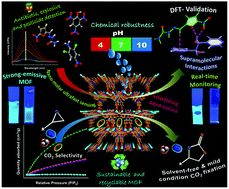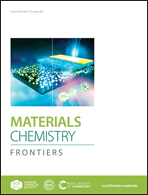Dual-functionalization actuated trimodal attribute in an ultra-robust MOF: exceptionally selective capture and effectual fixation of CO2 with fast-responsive, nanomolar detection of assorted organo-contaminants in water†
Abstract
Incisive amalgamation of open metal sites (OMSs) and functional group assisted pore decoration in metal–organic frameworks (MOFs) can accomplish selective capture and catalytic valorisation of carbon dioxide (CO2), and installation of luminescence attribute together with promotion of hydrolytic stability promise acute detection of multiple classes of water contaminating organo-aromatics, and pave the way for devising smart materials for diverse sustainable applications. Herein, we report the strategic construction of a chemically robust pillar-bilayer Cd(II)-framework, CSMCRI-9 (CSMCRI = Central Salt & Marine Chemicals Research Institute), from electron-rich tricarboxylate ligands, functionalized pyridyl linkers, and [Cd3(COO)6] secondary building units (SBUs). A combination of free –OH moieties affixed to the porous channels, OMS containing SBUs, and optimized cavities, generated via two-fold interpenetration, causes the activated MOF (9a) to display reasonable CO2 affinity (Qst = 28.21 kJ mol−1) with exceptional CO2/N2 selectivity (343.05) alongside multicyclic CO2 sorption. Benefitting from the synergistic roles of dual-functionalization and the co-catalyst, 9a delineates efficient solvent-free CO2 fixation with epoxides to produce cyclic carbonates in high yield under relatively mild conditions, exhibiting broad substrate scope and satisfactory reusability. The hydrolytic stability and strong luminescence signature of guest-free CSMCRI-9 allow aqueous-phase fluorosensing of assorted classes of harmful nitro-organics, viz. dichloran (DCNA), picric acid (TNP) and nitrofurazone (NZF), where each limit of detection value ranks top-tier among ultrasensitive luminescent MOFs. Impressively, 9a exhibits extremely anti-interfering and fast-responsive detection of all three lethal organo-aromatics with admirable regenerability, accompanied by rapid and visible paper-strip-based monitoring. Comprehensive density functional theory calculations validate the electron transfer route via portraying rarest alternation in the energy levels of the –OH group affixed linker by individual nitro-organics, besides evidencing linker–analyte supramolecular interactions, where varying degrees of energy transfer contributions explicitly authenticate the turn-off event.



 Please wait while we load your content...
Please wait while we load your content...